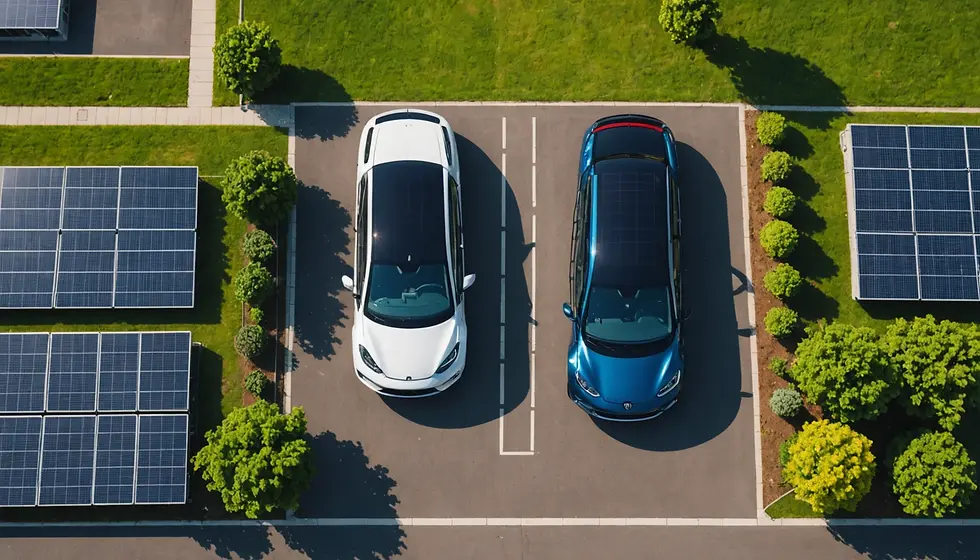Unleashing the Power of Self-Charging Electric Vehicles: The Next Frontier in Automotive Innovation
- Menno Drescher

- Jan 27
- 4 min read
As the world moves towards sustainable energy, self-charging electric vehicles (EVs) are leading a revolution in the automotive industry. Picture a vehicle that generates and stores its own energy, ensuring it is fully charged anytime you need it. This idea is not just a fantasy—it is quickly becoming a reality due to significant advances in technology.
In this post, we will explore the innovative technologies behind self-charging EVs, how they operate, and what this means for the future of transportation.

The Mechanics of Self-Charging
Self-charging electric vehicles rely on sophisticated technologies to capture and store energy. At the center of these systems are regenerative braking systems. These systems collect kinetic energy produced during braking to recharge the vehicle's battery, enhancing energy efficiency and extending the lifespan of brake components.
Using a Kinetic Energy Recovery System (KERS), self-charging EVs can gather energy while driving. For example, when a driver presses the accelerator, the vehicle collects energy and uses it when slowing down, improving overall efficiency. Research shows that regenerative braking can recover up to 70% of kinetic energy that would otherwise be lost.
Additionally, some self-charging EVs are equipped with solar panels on their surfaces. These panels convert sunlight into electricity, helping to recharge the battery, even during long drives. This capability can keep the battery charged for an extra 10-15% each day, significantly reducing reliance on traditional power sources.

Harnessing Energy from Various Sources
Self-charging EVs take advantage of various techniques to maximize energy generation. Thermoelectric generators transform waste heat from the engine into usable electricity, contributing an additional power source. For example, researchers have reported that integrating these generators can add up to 5-10% more energy efficiency.
Piezoelectric devices are another innovative approach. These systems capture vibrations caused by driving and convert them into energy. When driving over bumps or uneven surfaces, a vehicle can generate additional power through this technology, potentially adding another 2-3% efficiency.
Some designs incorporate small wind turbines, which can capture airflow and convert it into electricity while the vehicle is moving. This energy-generating feature capitalizes on natural resources, contributing to the sustainability of self-charging EVs.
Mechanical systems, such as flywheels, can store energy and provide power during high-demand situations, like rapid acceleration. This innovative approach helps ensure that self-charging vehicles remain efficient in various driving scenarios.
Optimizing Energy Storage and Management
Batteries are critical for the efficiency of self-charging electric vehicles. To make the most of energy harvesting, these vehicles require high-capacity batteries that can store power effectively. The latest battery advancements focus on increasing energy density and improving charging speeds. For example, some new lithium-silicon batteries can provide up to 50% more energy compared to traditional lithium-ion batteries.
Intelligent energy management systems play a key role in ensuring optimal use of power sources. By analyzing real-time data, these systems can prioritize energy usage, maximizing efficiency. For instance, when the battery is full, the system can redirect energy generation to systems like climate control, improving overall performance and sustainability.

Environmental Impact and Economic Efficiency
The rise of self-charging electric vehicles has significant environmental benefits. By reducing dependence on external power sources, these vehicles lower both electricity use and fossil fuel reliance. In fact, studies show that a shift to self-charging EVs could reduce overall emissions within urban areas.
As technology advances, costs are expected to decrease, making self-charging vehicles more appealing to eco-conscious consumers.
Challenges on the Road Ahead
Despite promising advancements, challenges remain. Research and development are essential to optimize various components to work together seamlessly. Ensuring the reliability of energy-harvesting systems across different driving conditions is vital for widespread adoption.
Cost also presents a barrier. Manufacturers must balance performance with affordability to ensure that self-charging EVs can reach a broader audience.
The Future of Transportation
As self-charging electric vehicles continue to evolve, they offer a transformative vision for transportation. The implications extend beyond convenience, potentially changing energy consumption on a larger scale. With less dependence on charging infrastructure, society could see a reduction in vehicle emissions, aiding in the fight against climate change.
Self-charging electric vehicles promise to improve urban mobility while fostering a cleaner environment. From easing traffic congestion to promoting sustainability, these vehicles open up exciting possibilities.
A Pivotal Shift in Automotive Innovation
The introduction of self-charging electric vehicles is a significant milestone in automotive technology. As we move forward, these self-sufficient systems for energy generation and storage will become essential for a sustainable future. With advancements in battery technology, smart energy management, and varied energy harvesting methods, the automotive industry is on the brink of a groundbreaking transformation.
In this evolving landscape of transportation, arriving home with a fully charged vehicle is not just a dream; it's becoming an everyday reality. Self-charging electric vehicles represent more than just a means of travel; they symbolize a step toward a greener, sustainable planet.
Though the journey ahead may be long, the destination is clearer than ever. Welcome to the future of driving!




Comments